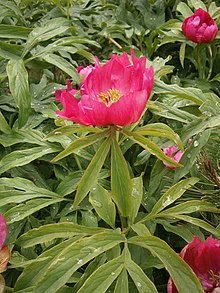|
Paeonia officinalis
 Paeonia officinalis, the common peony,[1] or garden peony,[2] is a species of flowering plant in the family Paeoniaceae, native to mainly mountainous areas of Southern Europe and introduced in Central and Western Europe and North America.[3] Paeonia officinalis was first used for medicinal purposes, then grown as an ornamental. Many selections are now used in horticulture, though the typical species is uncommon. Paeonia officinalis is still found wild in Europe.[4] The cultivar 'Rubra Plena' (deep crimson double flowered) has gained the Royal Horticultural Society's Award of Garden Merit.[5] DescriptionIt is a herbaceous perennial growing to 60–70 cm (24–28 in) tall and wide, with leaves divided into 9 leaflets, and bowl-shaped deep pink or deep red flowers, 10–13 cm (4–5 in) in diameter, in late spring (May in the Northern Hemisphere).[6] DistributionThe common peony is native to Europe in Spain, northern Portugal and southern France, Italy, Switzerland, western Romania and the Balkan peninsula and possibly northern Greece (Royal Botanic Garden Edinburgh 1998, Lupo Osti 2006, Aghababian 2011, GRIN 2014). It is widely cultivated elsewhere, but considered a native endemic of Europe.[3] There are six known subspecies:
TaxonomyMany synonyms exist for Paeonia officinalis, i.e. Moutan officinalis, Paeonia anemoniflora, P. barrii, P. baxteri, P. commutata, P. elegans, P. feminea, P. festiva, P. fimbrata, P. foemina, P. fulgens, P. fulgida, P. hirsuta, P. lanceolata, P. lobata, P. mollis, P. nemoralis, P. paradoxa var. fimbrata, P. peregrina var. officinalis, f. officinalis, P. porrigens, P. promiscua, P. pubens, P. rubens, P. sessiliflora, P. splendens, P. subternata, P. versicolor.[citation needed] GeneticsThe common peony is an allotetraploid with two double sets of chromosomes from different parents (2n+2m=20), so it is a hybrid or nothospecies. One of the parents is most likely Paeonia peregrina. The other parent is one of the group of very closely related species, Paeonia parnassica, P. arietina and P. humilis. Both these parents are tetraploids themselves. P. officinalis has by far the most extensive range and is one of the more abundant species in the Mediterranean region.[14] References
External links
|
||||||||||||||||||||||||||||||

